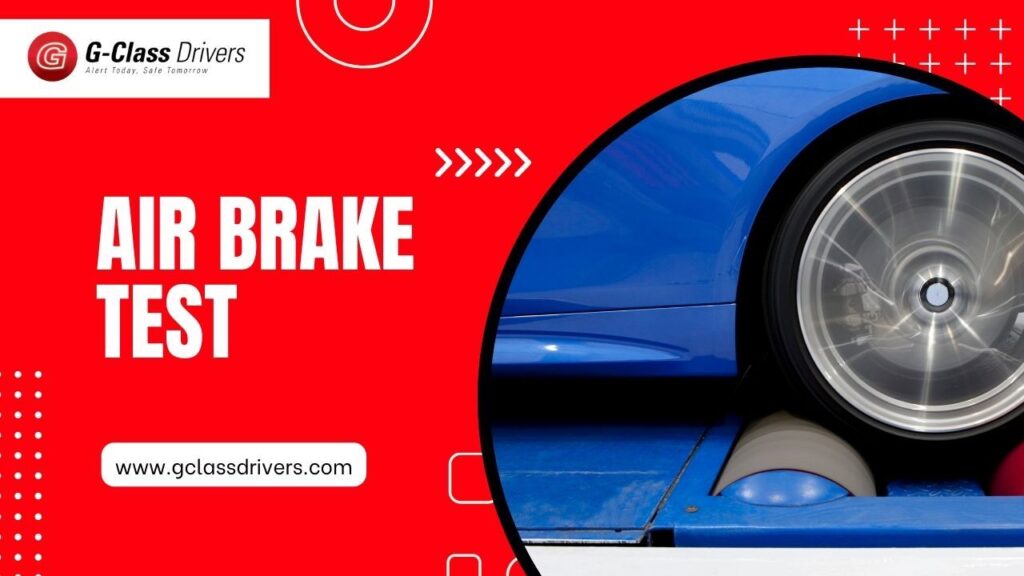Only in Canada, there are about 700,000 trucks, out of which 420,000 are used to transport goods. This means to ensure safe truck driving on the road, you need to pass the air brake test in Ontario.
So, ready to keep things on track? Explore the basics of the Ontario air brake test with us. To start your career in trucking, you need to obtain the Ontario Air Brake Z endorsement. This article explains the necessary requirements and tips to pass the test.
Read also: How to get an AZ License in Ontario
What’s The Air Brake Test?
The Air brake test is a requirement for applicants who want to drive a vehicle equipped with an air brake. Air brakes use compressed air to control and activate the braking mechanism. This provides a reliable method for slowing down or stopping heavy vehicles. The test is crucial for safety, as any issues with the braking system could lead to accidents or loss of control. Air brake systems consist of different parts like compressors, reservoirs, valves, and brake chambers.
Eligibility Criteria
The eligibility criteria for the air brake test are as follows:
Class D License (CDL)
A CDL is a professional license that allows applicants to drive commercial vehicles. To begin your career in trucking, Ontario Class D Truck Driver’s License is required.
Applicants need to have a Commercial driver’s license if they want to drive a truck. The specific CDL endorsements you require depend on the kind of trucking job you want to do.
Class A License
Class A license is a kind of commercial license. The license lets you drive vehicles that have more than two sets of wheels and weigh more than 26,000 pounds. With a class A license drivers are allowed to drive vehicles permitted by class B and C license.
Air Brake Test Criteria (Z Endorsement)
For getting your air brake test license applicants need to clear the written test. The test comprises 20 multiple questions that the applicant must pass. And the passing grade required for the test is atleast 80%.
Regarding the age, the minimum age limit for the test is 16 years old. But if you want to take the test and you’re under 18 years old, you need permission from your parents.
How to Proceed for the Test?
- Review the Air Brake Manual (PDF) to get ready for the Knowledge Test.
- Fill out the Application Information Form online with your details.
- Submit the form along with payment.
- Once your payment is processed, you’ll receive a confirmation email. Be sure to save a copy for your records.
- After receiving confirmation, you can either take the test immediately online or choose to complete it later by signing in using the access code provided in the email.
How Much Time Does It Take?
You have 30 minutes to complete the Knowledge Test, and you’ll usually receive your results instantly. However, if your online test is flagged for review, the results may take up to one week to be processed.
Cost of the Air Brake Test
The cost of taking the air brake endorsement test varies depending on your location. In most provinces, the fees include:
- The written test usually ranges between $25 and $50.
- If there is a practical assessment, this may add another $50 to $75 to the overall cost.
Check with your local testing authority for the most up-to-date fee structure.
Payment Options
Most testing centers offer several payment options, making it convenient to pay for your air brake endorsement test:
-
- Most of the testing centers allow payment through credit/debit cards when booking online.
- If booking in person, you can pay using cash, credit/debit card, or checks.
- Credit Card: In the case of credit cards it could be Visa, Mastercard, American Express, Discord, Visa debit, or Debit Master Cards.
It’s always a good idea to confirm the available payment methods when booking your test.
Available Languages for Test
Currently, the Knowledge Test is offered online in:
- English
- French
If you need to take the test in a different language, you can contact the Registry of Motor Vehicles to explore your options, including the possibility of using an interpreter.
Tips To Pass
For passing the air brake test following are some of the tips given that can help you:
- The official Commercial Driver’s Handbook is the best resource to get prepared for the test. You can get all the information you need about the air brake systems.
- By attempting the air brake practice test, you can have an idea of what will actually be in the test.
- During the test, stay calm and focused. Remember the procedures you’ve practiced, and don’t rush through the steps. Take your time to do everything accurately.
- While driving, be aware of your surroundings and identify potential hazards. Your examiner will assess you on these.
- Along with this, avoid any kind of distractions. The biggest distraction is mobile phones, which have caused a major number of accidents on roads.
- Another way that will help you pass the test is to study with someone that has already taken the air brake test.
- Practice driving a vehicle with air brakes. This will help you get comfortable with the different braking characteristics compared to vehicles with hydraulic brakes.
- Regularly practice pre-trip inspections on vehicles equipped with air brakes. Learn the different parts, look for problems, and make sure everything works well.
What If You Fail The Test?
There is a chance that you can’t pass the test on the first attempt. Anyone can make mistakes, so it’s not a big issue. In case you fail the test on the first attempt, then you will have to wait for a while. A fee is also required for retaking the test. Also, Gclass drivers are also here for you. The experienced instructors will guide you at every step.
Conclusion
In conclusion, passing the air brake test is a vital step for applicants who want to start a career in trucking. The significance of the test lies in its role in assessing the knowledge and skills necessary for operating vehicles equipped with air brake systems. Comprehensive testing process involves a written knowledge test as well as a practical road test.
To excel in the test, applicants are advised to tap into resources such as the official Commercial Driver’s Handbook and practice tests. Staying composed, focused, and attentive during the test is necessary, along with developing an acute awareness of the surroundings and potential hazards. Ultimately, passing the Ontario air brake test isn’t only about passing it; it’s about ensuring the safety of oneself and others on the road.
FAQs
How do I get an air brake license in Ontario?
To get an air brake endorsement in Ontario, you must complete an air brake training course approved by the Ministry of Transportation. After finishing the course, you need to pass a written knowledge test at a DriveTest center. Once you pass, the air brake endorsement (Z) will be added to your driver’s license.
What is the 7-step air brake test?
The 7-step air brake test involves a thorough inspection of the brake system to ensure it is functioning properly. Key steps include checking the air pressure, compressor cut-in and cut-out pressure, air leakage, low-pressure warning device, and ensuring the emergency brakes activate automatically when the pressure drops.
How much is the air brake course in Alberta?
In Alberta, the cost of an air brake course typically ranges between $200 and $300, depending on the training provider. This fee usually includes both classroom instruction and practical training.
How many questions are on the Alberta air brake test?
The Alberta air brake knowledge test consists of 25 to 30 multiple-choice questions. To pass, you must correctly answer a minimum of 20 questions.
What is the PSI for air brakes?
In most air brake systems, the normal operating air pressure is between 100 and 120 PSI (pounds per square inch). The compressor cut-out pressure is generally set around 120 PSI, and the cut-in pressure should be around 100 PSI.
How to test an air brake system?
To test an air brake system, start by conducting a pre-trip inspection, checking for air leaks, and ensuring the air pressure builds up properly. Perform a static pressure test, applied pressure test, and check the brake system warning devices. You should also ensure the emergency brakes activate when pressure drops below a specific level.





